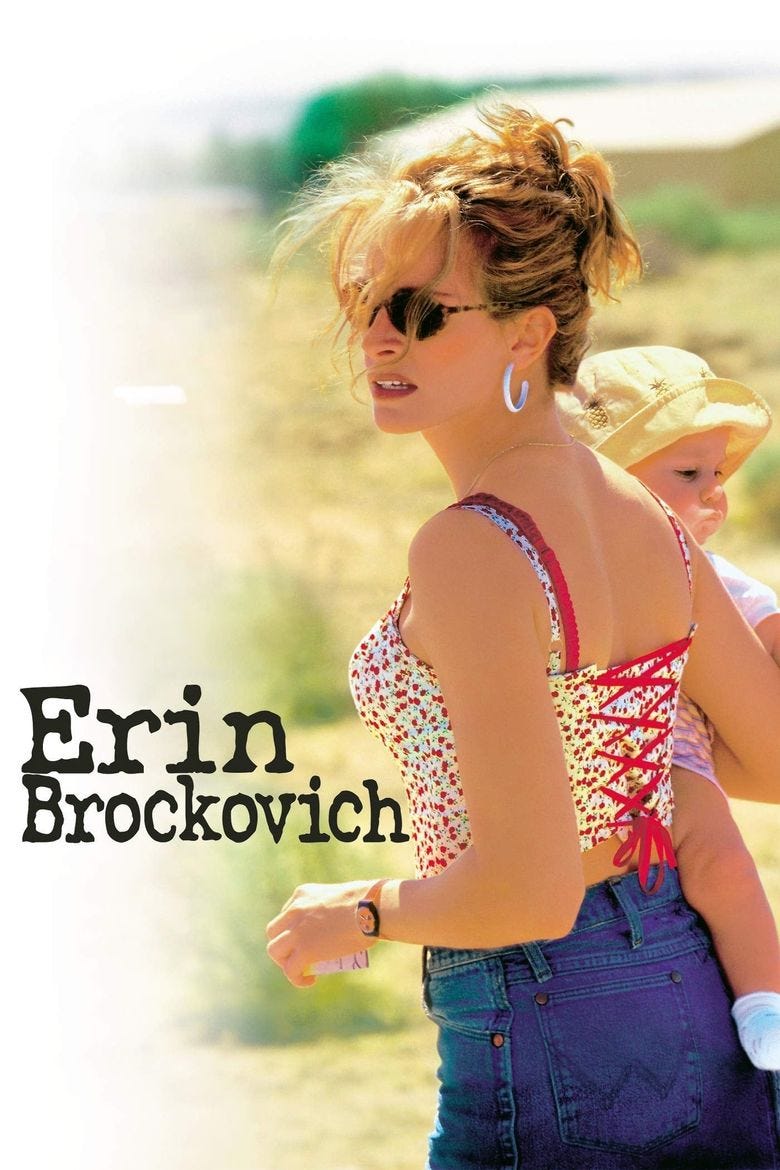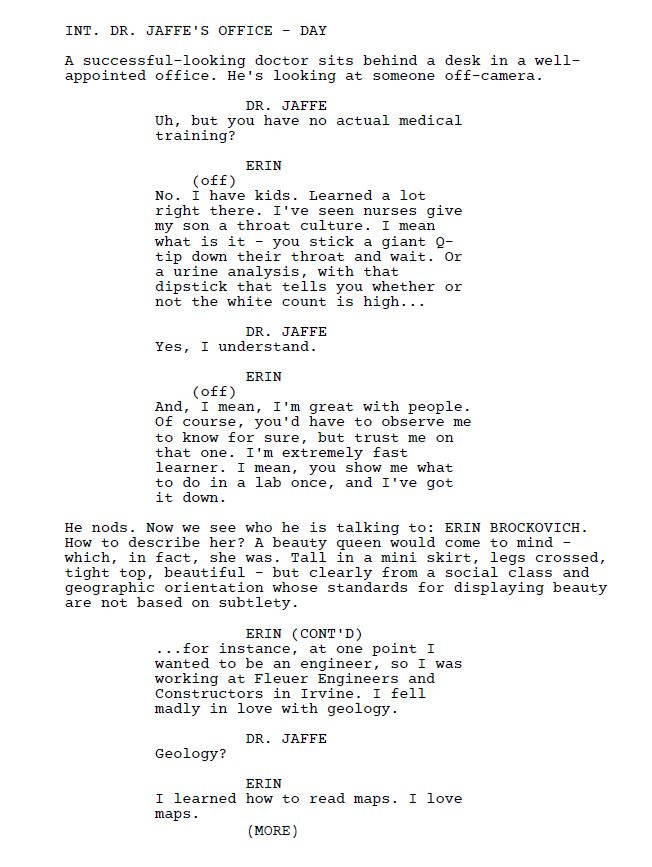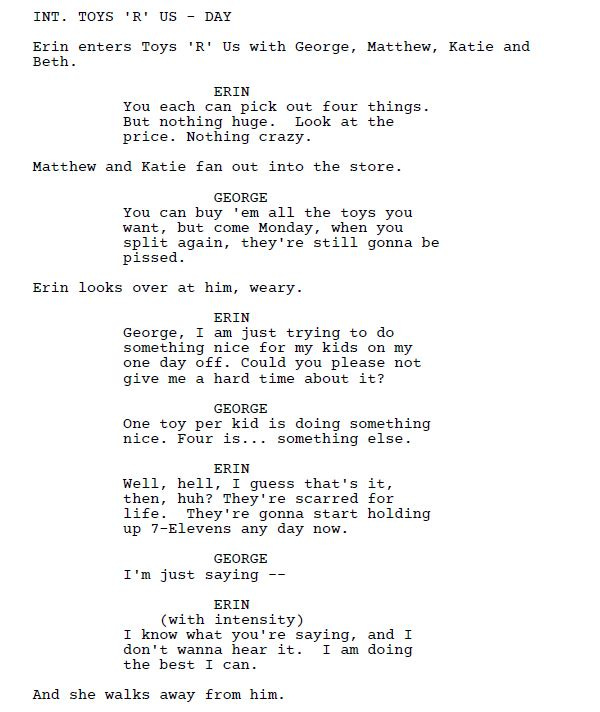Erin Brockovich (2000) Script Review | #78 WGA 101 Greatest Scripts of the 21st Century
This biopic of Erin Brockovich starts off on a strong note, but then unfortunately loses some steam halfway through and never completely quite recovers.
Logline: An unemployed single mother becomes a legal assistant and almost single-handedly brings down a California power company accused of polluting a city's water supply.
Written by: Susannah Grant
Revisions by: Richard Lagavanese
Pages: 139
Erin Brockovich begins with promise, falters halfway, and loses some of its heft by the end. It doesn’t help that despite its triumphant ending, the one in which the evil corporation must pay the community it has poisoned, the real-life victims of the litigation in the story barely saw even a fraction of the millions promised as compensation. Which, as you might imagine, somewhat sours the reading experience.
The screenplay is based on a true story about a true person. Erin Brockovich, a former pageant beauty queen and unemployed single mother, convinces the partner of a law firm to hire her, and she uncovers a long trail of records that prove a Californian power company knew that their power plant was polluting a small city’s water supply and causing great harm— and continued doing so anyway. (Nothing has changed today when it comes to large corporations, has it?)
Rather than make the case the central focus of the screenplay, writer Susannah Grant opted to focus on the woman at the center of the story. The spine of Erin Brockovich thus becomes the intertwining tales of Erin’s personal and professional lives— her working relationship with her boss, Ed Masry; her children; and a burgeoning relationship with the next-door neighbor, George. The conflict springs from— quite naturally, I might add— the protagonist’s difficulty in balancing work and life, as the case begins to consume her time at the expense of her kids and new beau, who looks after them in her absence. It is, probably not intentionally, a rare reversal of roles where the man is relegated to the sidelines and defined largely by his relationship to the woman.
Who is Susannah Grant?
Susannah Grant (born on January 4, 1963) is an American screenwriter, director, and producer, who developed a passion for storytelling at a young age, driving her to pursue a career in screenwriting when she enrolled in the prestigious American Film Institute in Los Angeles. After landing a writing job on the popular TV series, Party of Five, she had her breakthrough moment in 1995 with the screenplay for Disney’s Pocahontas. She followed this up with Ever After (1998) and 28 Days (2000), the latter releasing the same year as Erin Brockovich, which earned Grant an Academy Award nomination for Best Original Screenplay.
Over the years, she’d pen the screenplays for a variety of projects of different genres and themes, spanning from In Her Shoes (2005) and Charlotte’s Web (2006) to The Soloist (2009). She also sat in the director’s chair for episodes of Party of Five, Catch and Release, and the TV series Unbelievable. Her latest work was serving as an executive producer on the successful Apple TV+ adaptation of the best-selling book, Lessons in Chemistry.
***
While I was ultimately underwhelmed as Erin Brockovich squanders its potential, there’s a lot to like and a good deal to learn from the screenplay. For starters, it cleverly uses the opening lines of dialogue to establish right off the bat that:
Erin in unemployed;
Erin has no professional qualifications;
Erin is a single mother;
Erin is dedicated, hard-working, and is quite adept at working in fields in which she has no formal training;
Erin is willing to learn;
Erin is adaptable;
Erin is willing to put herself out there to get a job.
The scene in question is brief- two pages- but it offers an excellent way to provide exposition without feeling like exposition (because Erin is interviewing for a job and selling herself as to why she would be a great candidate).
Moreover, you can tell the screenplay’s age (it was written in the late 90s and came out in 2000) because it is often the older screenplays that expend some energy in character descriptions.
The trouble with biopics like Erin Brockovich is that, no matter the subject, they tend to follow an often-predictable trajectory that fits within the traditional screenplay structure than the person’s real-life chronology. I am in no way saying that it should rigidly stick to the facts— that’s the job of a documentary— but scenes such as the outburst on page 76 feels a little out of the blue, as if owing to the requirements of the script, it was deemed that some conflict was needed.
What difference does it make to focus on the character versus the case? The best way to highlight them would be to compare them with other info-heavy screenplays such as Moneyball (#56 on the WGA List of 101 Greatest Screenplays of the 21st Century) or The Big Short (#55); in these scripts, the writers balanced the characters with providing heaps of technical information to make the reader understand what was happening. In Erin Brockovich, Grant avoids wading into the weeds of the technical information about how the company is polluting the water, giving us enough to understand the gravity while keeping more space for the performer to deliver some strong acting (it paid off, too, with a Best Actress Oscar win for Julia Roberts).
The downside of the second approach, as you might have noticed, is that it errs the script on the side of predictability. Is the main character stubborn and a rule-breaker who gets results? Check. In such a situation, is the case going to be taken from her once the experts step in, leaving her feel betrayed? Check. At the eleventh hour, will she find an ace-in-the-hole to deliver the victory that feels out of reach? Check, check, check.
Still, Grant finds a way to arrange these scenes in ways that avoid complete predictability. Moreover, she has a good eye for using imagery to create atmosphere…
… while spitting out some truly uproarious one-liners courtesy of a cheerfully foul-mothed Erin.
Despite my limited enthusiasm, I think Erin Brockovich has its merits and offers a lot to teach, especially in writing scene descriptions and dialogue. Like Schrödinger’s Cat, it’s one way to write a biopic, and it’s one way not to write one.
Notes:
Dorian, Marc; Gorin, Tim; Yamada, Haley; Yang, Allie (June 10, 2021) Erin Brockovich: the real story of the town three decades later | ABC News
Ferrari, Alex (May 19, 2023) BPS 300: How I Wrote Erin Brockovich with Susannah Grant | Bulletproof Screenwriting













